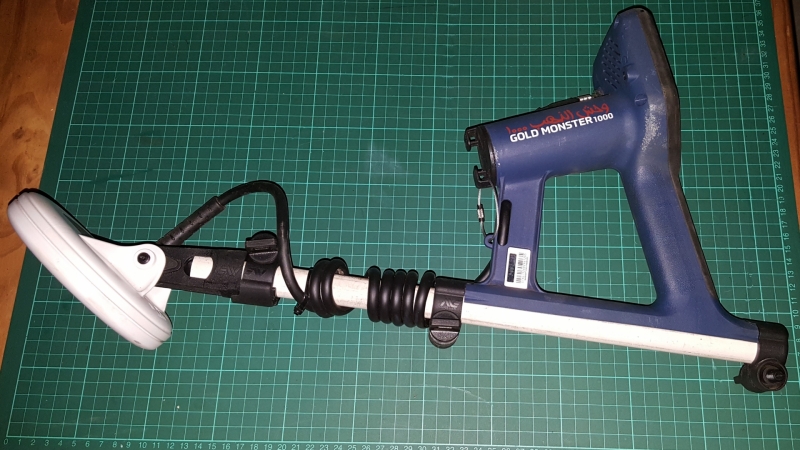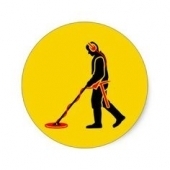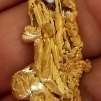Leaderboard
Popular Content
Showing content with the highest reputation on 07/31/2017 in all areas
-
Decided to take the Monster out from under the bed and up into the hills for a couple hours today. Used JP's recommended procedures outlined in his Minelab blog and it worked very well. Also taped the coil lead of the 5-inch coil to the shaft very close to the the coil as posted elsewhere on the forum. While it didn't completely eliminate the falsing that occurs in max sensitivity when bumping the coil, it was greatly improved. Altogether, the Monster located a dozen flakes of gold this time out. The total weight is 2.5 grains, or 0.2 of a gram.15 points
-
I got a call at my business the other day. A miner was desperate to get some reclamation work done. I thought I had this guy pegged as another miner that made a mess on public land and now he is being told he has to clean it up. I was wrong. I ask his where the work was and what needed to be done. When he told me I told him this could cost several thousand dollars. He said he well understood the cost involved but the U.S.F.S. was going to keep his bond in addition to charging him for them to do the work which was several times more expensive than what I told him my work might cost. The work was to construct erosion control in his access road, remove a section of the road, and block off the road from future access. This didn't sound right and I told him I needed to see his Plan of Operation. He drove 100+ miles to bring me a copy of his plan. It was for occupancy for more than 14 days and to construct and maintain an out house- nothing more. The bond amount was extraordinarily excessive. I called the U.S.F.S. minerals officer to try to get a better understanding of the situation. She said that she considered the road as part of the reclamation. I replied "maybe it was but it wasn't part of the plan". She didn't care and if he didn't do as told he would be charged for the costs of the U.S.F.S doing the work. Somehow I managed to hold my smart@$$ mouth and my temper and politely said I believed the historic public road was protected by statute and she was acting outside of their own minerals administration guidelines, that if I could be shown a regulation, forest rule or any thing the claim owner signed or initialed that obligated him to eliminate his own claim access or something that gave her the authority to make these demands, I would immediately load up equipment and do the work otherwise I would need a better explanation from District Forest Ranger and Forest Supervisor. The claim owner received a call soon thereafter and was told he did not have to do the road work. The claim owner nearly spent thousands of dollars needlessly. So if any of you own a claim, please take the time to familiarize yourselves with regulations that apply to you AND regulations that apply to the regulators. Claim owners have more rights regarding their claims than what most realize. Please-no anti government rants if you reply. Thanks. Klunker14 points
-
4 points
-
With a bit of research looking at old topo maps and aerial photos, I found another promising site 5 minutes from my home. It's currently a school built about 25 years ago with a nice size sports field. What I found is that an older school was previously located where the sports field is now. Bingo! Along the street I could see old sidwalk and concrete steps outside the school fence so decided to start there on Saturday. Fisher F75 w/5"x10" concentric, de (default) process, gain of 70, no disc, 4H tones. Quite a bit of trash, but still manageable with this coil. Found a couple copper pennies (one at 4" depth, other a bit shallower) which I couldn't identify -- good sign -- so put them in the secret slot of my nail apron. After about 3 1/2 hours of my allotted 5 I decided to switch to the 5" DD round coil (otherwise same settings) and test the schoolyard on the other side of the fence, but still in the shade. Might have been my first hit -- boucing a bit but in the 'good coin' range (i.e. higher than Zincoln) so started to dig. I had a couple issues with this hole: 1) 1/8"-1/4" roots of nearby tree -- try not to cut those, this isn't my property..., and 2) about 2-3 inches down I was hitting crushed stone. Was this previouly a driveway, or was it backfill? I should have been a bit more careful but when it's getting later in my hunt I'm tired and tend to work fast (sloppy). About 4 inches down I see white metal... Could it be? Out comes a coin and turning it over I see the classic reverse of a Mercury dime! My research has been justified; this is an old site. Kept searching but nothing else turns up of value. End of day 1 but I already have plans for day 2, even though I have other plans/tasks and won't be able to get out as early or for as long. (Good news: my sloppy digging/prying didn't mar the coin, but lesson learned?) Day 2: decided to try put the concentric coil back on and return to where I found the Merc. I'm getting a lot of clipping of signals (recall, no disc so that isn't it) and start wondering if there is a problem. Then I remembered how many overloads I had gotten with the 5" DD the day before. Was this area littered with sheet metal scraps large enough to cause overloads and clipping? I kept going without success, then decided to wander over to another spot near the fence (less likely backfilled). Got a strong signal with high ID but when pushing the coil close to the ground (better pinpointing and ID determination) the detector overloaded. Hmmm, this seems like a small target, but overload? Pop can? I decided to investigate (I'm one of those paranoid searchers that just knows that as soon as I skip one it'll be the Heart of the Ocean ) so I push the tip of my Lesche down about an inch and out pops some kind of silver(?) jewelry, annular shape (but not a finger ring). Into the hidden pocket for later inspection. As I return to where I found the Merc my eye catches something very bothersome -- a 3-4 inch diamter hole in the ground, rather deep. Had I forgotten to fill in my excitement yesterday? But where is the dirt pile? I'm sure this is something I had dug, but I never fail to backfill. In fact, after cutting a sod plug, everything that comes out of the hole goes into a gold pan I carry just for this purpose. Empty the pan back into the hole and replace the plug. I didn't leave my gold pan so I had to have refilled. WTF?? Well, I need to fill it back in so I look around for some stones. Peering on the other side of the fence (there was a deep drainage cut next to the street and I had seen rubble there yesterday which would work) I see another similar hole! Now I'm really annoyed. Is this why detectorists get banned, accused of not filling their holes? Obviously some animal (humans are animals, too) had re-excavated a couple of my holes. After filling in both I have a decision to make -- should I just cut bait and jump ship? I don't want any more of this to happen. This is a schoolyard and kids can twist ankles in such a hole. Then I decided I hadn't done anything wrong. Why let someone ruin my day? With the signal overload still on the back of my mind, I decided to switch to the Fisher Gold Bug Pro with 5" DD and see how it performs. I also was curious to see what ID's it shows. Retracing my tracks inside the fence I confirm with several overloads -- something big is under the surface and I'm not digging it. Also, the sun is moving such that I'm running out of shade inside the schoolyard and I recall that I had left some ground unsearched outside the fence (where there is shade) so back there I go. The usual junk (foil, grrrr) but before my 3 1/2 hours are up I made three interesting hits which I'll finish with here before showing the loot haul. A) Getting an inconsistent ID near nickel 5 cent -- that is typical of ring and beavertail so this is my guess. Handheld pinpointer (White's TRX) signals so I dig and find a small nail. Now most of you know that nails, depending upon orientation, can be all over the ID scale. Was this it? Then I look in the gold pan and there is round disk -- had already pulled it out without noticing -- dark (nickel size) coin. So the signal was jumpy because I had two targets, one good and one bad. I'm learning all the time. B) searching right along the vertical edge of the concrete sidewalk I get a high ID (but not clean) and decide to dig. Nothing on the TRX at first, but then a couple inches down it sounds off, and a bit more digging reveals a tiny ring. How can that read high? Back over the hole with the GB-Pro and another signal, this time some junk (can't remember but probably wad of aluminum foil). Was the high tone from the junk? Did I even get a signal from the ring or was this find completely serendipitous? Into the hidden chamber! C) about out of time, I get a strong coin (copper penny or dime) hit and figure it's close to the surface, probably a recent drop. Immediately I see an exposed tree root right where the signal is. Have to dig around that. TRX sounds strong and as I work my way around the root it seems like it's actually inside the root. Now what? In the past when this has happened I've just thrown in the towel, not wanting to damage anything. But I noticed the root appeared to split into two branches so I pried between and out pops a penny. Hmmm. I still figure it's new (Memorial, but not Zincoln) and put it into the pouch. Done for the day, I decide to attempt to atone for my sins (holes I dug, filled, and someone else redug) so I gather up a bunch of trash that the wind had collected along the fence inside the schoolyard and headed home. The picture shows my good finds. The two days yielded 4 Zincolns (junky looking, as typical), 2 Jeffies ('77 and '81), one clad dime and one clad quarter. No copper Memorials but 3 Wheaties -- a '46-D from day 1 and a 1919 (considerably worn) -- this latter being the one nearly on the surface stuck in the tree root! The Merc is in nice condition but a super common date (1941 plain = Philadelphia mint). I suspect the gold ring is cheapo plate with a glass 'stone' but need to investigate further. I'll also do a specific gravity measurement on that other piece of jewelry to see if it is really solid silver or just silver plate. Neither of these had any markings that I could see. My find of the hunt (from day 1) is the pictured penny -- 1932-D. Without considering the scaling from decades in the ground, the condition is approaching extremely fine (EF) based upon the lack of wear to the reverse wheat stalks. I'm soaking in olive oil per advice from SS-Al and Deft Tones, hoping this will clean up the scales. Looking at my Redbook, I count 140 date+mintmark 'business strikes' (meant for circulation) Wheat pennies in the 50 years (1909-58) they were minted. The 1932-D is #16 in lowest mintage. This is easily my scrarcest Lincoln detector find ever. With the scales it's not worth much, and even cleaned up it's likely only worth a few bucks (haven't searched Ebay for the appraisal), but it's still a top find for me. Conclusion: In the past 7 weekends I've found old coins at all four sites within 10 minutes of my house. I'm not done searching any of them. However, I recall reading here (sorry, forget who the posters were) that some recommend to stop digging in the dry season in public places (like my parks and schools). I'm going to heed that advice. It's less likely that whoever redug my holes would have done so or made such a mess if it weren't dry season. Besides, I have some creeks to hunt which just might (very great longshot) yield my first detectable gold or possibly some coins. Crazier things have happened. That will keep me busy until the fall rains. And if I have just a little time to spend I'm going to work the backyard on my digging techniques -- try for smaller holes. That's gotta help in the long run, too.3 points
-
A video I made that might help someone who uses a Google Earth and wants to transfer that data onto a GPS. I use this all the time to quickly drive/walk into areas that I've researched online. My other video that I did shows you how I overlay old maps onto Google Earth. Hope it helps at least someone.3 points
-
Not really, Tom. In addition to Tesoro's I had along, I used all three Nokta models I rely on, the Impact, FORS Relic and FORS CoRe. They don't have a preset 'mode' or 'program' like some makes and models, such as 'Beach,' Coin,' Relic,' etc. that have pre-configured Discrimination or rejection segments. Instead, these three models provide open, programmable modes such as 'GEN' or All Metal, 'COG' which is a Conductive Ground or Beach mode, and 'Di2' or 'Di3' which are simply Discriminate 2-Tone or Disc. 3-Tone modes. In addition the FORS Relic has 'SWT' for Swift and 'DEP' for Deep modes. The Impact has Deep and seven additional search modes, but all of them let the operator make adjustments on the fly to all their settings, plus any settings can be Saved as desired. The main settings I have in ALL of my programmed detectors at turn-on are similar. That is the Sensitivity, or Gain, is close to maximum, and the Discrimination is set to just barely accept nails. That is because most of my hunting sites are iron infested ghost towns, homesteads, stage stops or any sort of old site of human activity. Iron nails are quite common at virtually all of them and 90% of the time I like to hear the presence of iron so I can methodically work the coil around it to unmask keepers. The other 10% of the time I might be really tired of abundant nails, or I am just doing some quick cherry-picking and I increase the Disc. level to just barely reject iron nails. That is also a setting I use when evaluating ANY make or model in order to see how their performance compares with most Tesoro models on my Nail Board Performance Test. I do have a Vaquero and Mojave which have broader Disc. adjustment ranges that adjust low enough to accept nails, which I can then reject if desired. But I compare ALL detectors to my other Tesoro models that have the ED-120 Disc. acceptance range and, at their minimum setting, nails and most iron are rejected. So all my Nokta units I demonstrated didn't really have any "adjustments made specifically" for Nail Board demonstration, they are just set to function as they would any other time I put them to use. For example, the Gain on all three units in Di3 is at '99' and in the GEN or Di2 modes it is '95.' The Disc. is set to just barely accept nails, so the ONLY changes I made from turn-on operation were to increase the Disc. to the numeric read-out where nails were just barely rejected. The FORS CoRe and FORS Relic have pre-designed Audio Tones for the Low Iron Audio and a VCO enhanced High-Tone in every mode except Di3, and those are a set Low Iron Tone, a pleasant and clear Mid-Tone, and an even more distinguishable High-Tone. I hear many detectors with a factory engineered audio tone that just isn't as pleasant or distinctive to me as I would like. The Nokta Impact, like their sister company's Makro Racer 2, features Audio Tone Adjustment and that let me adjust the audio Tone (the Pitch or Audio Frequency) to a level that is best for my impaired hearing, and that provides a very clear alert of a target in that conductivity range. Using any multi-tone search mode, be it 3-Tone, 4-Tone, 7-Tone, 8-Tone or even 85-Tone (which would be Di99 on the Impact) can result in a muddy or blended tone caused by the sample target, such as a coin, and the interference and response from the four adjacent nails. That's why when I am searching most sites where only nails are the primary ferrous object I deal with, I favor any of the 2-Tone modes, where the fixed, non-VCO lower Iron Audio Tone can be heard, and the higher-conductive target sort of 'jumps out at you' with a VCO enhanced High Tone that you can't ignore. So, no, my Nokta's didn't have any 'specific' settings made that would favor the performance just in that test. They were basic settings at high gain and they work well. I will say that I was pleased to see the White's MX Sport pass my NBPT which means getting a minimum of 6-out-of-8 hits. I personally want a detector and coil in-hand that gives me no less than 7, and preferably 8-out-of-8 on that test. While the MX Sport gave digable hits, I also have to say that the Audio Tone, for me, wasn't all that remarkable. It was almost like a muddied-up Iron Audio, at least to me. If those Audio Tones are adjustable on the MX Sport then I might find it more appealing when searching for a waterproof detector. It was great meeting you in Idaho, and I really enjoyed the video you made. Too bad White's didn't make their own 7" DD search coil for the MX Sport, and I really think they missed the boat by not using their 6½" Concentric coil. As well as the 950 performed, can you imagine field performance if they worked up the 5.3 Eclipse (6½" diameter) Concentric coil for the MX Sport! Monte2 points
-
Don't worry, went back and re-read the sensitivity treasure talk. Answered my own question. In Auto+, the detector still chooses the best equivalent of the 10 available manual settings and Where Manual 10 is the maximum level that can be user selected, the auto level selected mayrange above 10 if the ambient and ground conditions allow, giving a greater sensitivity than manual will ever be able to achieve. Senility may be creeping up on me2 points
-
Thanks to all for the information. Ran about 4 hours on Saturday and it dropped 1 bar. Got 2 little bits 1 grain and 7/10 of a grain it will find small gold.2 points
-
They warn you how not to use a Hi-Lift but so many people ignore the warnings, the key to safety using a Hi Lift is to keep both hands on the handle and you control the handle keeping both hands on it at all times, and hold the handle up against the upright when moving the direction lever, and then keep both hands on the handle. John.2 points
-
Finally got the GM1000 out on the lode mine gravels I have access to. The small coil picked through the iron and trash easier than my GB2 did, and with it being so hot it was REALLY nice not having headphones on. Dug lots of crap, but eventually got a couple nice specimens. Tomorrow, up to one of my favorite benches if I can get across the creek! :-)2 points
-
I don`t own a claim and don`t understand how these situations reach the level that they do. Is it ignorance on the part of the miner or does the fault lie with inept forest service people out stepping their jurisdiction. Is there any recourse or review within the forest service itself to prevent these problems before money is needlessly spent? Seem both parties should be working together, not against each other.1 point
-
1 point
-
1 point
-
This is a long post, so if you are in a hurry you can just jump to the end to see the (fuzzy) pic. I've been searching a particular muni park for about a year now. It has been a city park since the late 40's, and in the late 19th and first quarter of the 20th century it was a stone quarry which eventually filled with water and became a swimming hole (legal or otherwise). You wouldn't know its history from looking, though. I'd estimate I've hunted there for 40-50 hours and two best finds are a 1900's Indian Head and Civil War button (don't know how that ended up here). About 6 weeks ago I noticed that an old tree overhanging the park (but appearing to be on a private lot with house) had been surrounded by one of those orange plastic fences with associated "keep out" signs saying something about "vegitation protection". At first I feared I might even share some responsibility since I've dug under that tree multiple times. Did I damge the roots? I decided to lay low and work in my other parks and schoolyards until the vigilante posse tired and went home. Last week while driving by I noticed that the house (with the tree on its property) was gone! Unfortunately much of the lot had been dug up and smoothed, but quite a bit was still in its original sodded state. I fairly quickly reached a conclusion (which might not be right) that the city had bought the property to append to the park. In my possibly faulty thinking this made it fair game for hunting. I was out-of-town for the weekend but the morning of the 4th was open, so.... I took all three of my VLF's with small coils (5" round on F75, 6" 7.5 kHz round on my X-Terra 705, and 6" coiltek prototype DD on the Gold Bug Pro). I started with my new F75 in discrimination 'de' (default) process wide open for any metal, 4H tones (four in number with nickels hitting high), and I think a gain of about 90. Started swinging at 6:55 AM and within a couple minutes had my first positive signal. I tend to dig-it-all (except ferrous and maybe foil), at least starting out, so pulled out the Lesche (garden trowel size) and at about a depth of only 2.5 -- 3 inches (7-10 cm) out popped the all too rare glint of silver ("silv in the hole!" as KG and Ringy like to shout, but I kept silent). Those of you who coin hunt know that most of the time (all the time in my limited experience) you know silver immediately because unlike copper, nickel 5c, nickel clad, and the disgusting zinc coins, silver doesn't tarnish/discolor in the ground. First good target = first dig is a silver Mercury dime. I avoid rubbing coins right out of the ground and I don't wear bifocals anymore when hunting so I couldn't see a date if I wanted. But I knew the coin design I had. Date to be determined later. By about 8:00 AM, with a few more good targets (copper pennies, but I couldn't see a Memorial and, as above, wasn't about to rub to find out) I decided to switch to the Gold Bug Pro. After another hour I went to the X-Terra 705 and finally with only about half an hour remaining before I had to get home and cleaned up for a holiday reunion I went back to the F75, but this time in fa ("fast") process. (Since my original dig I had not found any real silver, but in total I had 11 copper pennies, one Stinkin' Zincolnd, and one clad dime.) In my very limited experience, fast process is much more susceptible to EMI, and I have a Digital Shielding Technology (DST) version F75. So I turned down the gain to about 65-70 range, still quite high compared to many detectors. I looked at my cellphone a while later to see "10:30" and decided "time for one or two more digs" and quickly got an 83 reading, which is right where quarters are supposed to hit on the F75. Down about 4 or so inches I experience another coin hunter's high -- the white reeded edge of a silver US quarter! You now have probably figured out my title -- 'covers' = first and last digs of the hunt are the best finds of the day. Although my picture taking is so bad you probably can't read the date on the Merc, it's a 1937 in F-12 condition. The 1940 Washington is well worn ('G' condition might even be stretching it). Neither has a mintmark and in terms of worth (to anyone but the finder ) these have silver bullion value only. Of the 11 coppers, 6 Memorials and 5 wheats, with the oldest being 1916 (plain = no mintmark, so Philadelphia); two in the 40's and two in the 50's, with none being key/semi-key dates+MMs. As mentioned, one Zincoln and one clad dime. Amazing (to me) ratio of old to new coins. This weekend looks like another opportunity and I've only covered about 50% of the undisturbed ground in that lot, so fingers crossed for more excitement.1 point
-
1 point
-
Does he have special tan lotion for the tops of his feet? Maybe you can send him those thongs with a couple of 'drink size' umbrellas so he won't get the digits sunburned!1 point
-
From Youtube. One of the better vids kicking around. I wasn't sure where to post this but here seems as good as anywhere. In the vid it mentions that auto sensitivity utilises the sensitivity settings 1 to 6. I hadn't heard that before - maybe I missed it? Is it correct or an assumption? Thanks, Adam.1 point
-
It is a shame that Dave Emery's Pulse Devil project did not reach the market as some of his work is incorporated within the QED.1 point
-
Very nice. I like nooks and crannies and CRUMBS. I also think JP's start up procedure is very important.1 point
-
Well, to be honest, try to describe anything in detail in writing and it can come across as complicated. For instance, describe in detail how to know which settings are best on a GPX 5000 under different conditions. I can tie my shoes without thinking but to write down the steps involved can make it sound intimidating. It's somewhat inherent in the medium if you want to be sure the information is detailed and complete.1 point
-
I wish you well too John, your equipment posts are great, thanks the taking the time.1 point
-
Although, my favorite all time coil...Detech 15x10 Mono E. This little wonder has found nuggets form .09 grams and above at great depth. Its light for all day use, and when bumping against rocks and plants, shrubs it stays silent unless its over a target. I found this size perfect for long daily use. This was a multi grammer found pretty deep, can't recall how deep but looking at the hole....it must have been down 16 inches as the coil from front to back fit in it.1 point
-
This is VANursePaul on Dave's computer---- Well the day has arrived!!!! After a last shower and a quick brekkie... we finish loading out Looks like a 5 hour drive out to the area we are going.... bush track the last part...... We will get to see how tough the Subaru is today. It is an understatement to say I am excited... From the moment I set foot in AU I have been overwhelmed by the hospitality of all who have helped make this trip possible.. Wonderland?????----- Yeah mate, I'm soaking in it HH to all of you.... paul1 point
-
I almost always use a classifier when panning. It both greatly speeds up the process and you also get better recovery. Double benefit. Personally I normally used one of the standard plastic classifiers. Always at minimum give the oversized discards a quick eyeball - you don't want to toss a large nugget!1 point
-
What Deft Tones said, with the exception I'll go stronger on any possible downside by saying 'it shouldn't' instead of 'probably will not'.. ( Nickels are a copper-nickel mix of .750 copper & .250 nickel and have remained as such since first minted in 1866.. This is the same mixture / ratio modern day "silver" clad uses over a solid copper core.. ) The main reason I don't know for sure is because one of my side things is "copper" pennies, wheats & memorials 1909 - 1982.. I chase errors: RPMs (repunched mint marks,) doubled dies, off-center strikes, die cracks, etc., etc.. I normally buy bags of loose cents and boxes of rolled cents for this, but have had one nice out-of-the-ground find.. For the most part coins are just other things found while hunting jewelry.. Consequently the only coins I've ever run through olive oil are pennies from this timeframe.. The thought of running anything other than these never even really crossed my mind until a couple months ago.. So right now I have a couple of beach quarters, a brownie & a greenie, about six weeks in -- just to see what happens.. From the looks of them so far it appears they'll be in the soak at least six months.. Will keep y'all posted.. I don't know why, but to me at least long-time beach quarters always seem to end up so much more gnarly than beach dimes and nickels.. Since modern day silver clad and nickels are all of the same composition though, I was figuring how one reacts so will the others.. Now that this thread has come along though I should probably get dimes & nickels going.. Should get inland finds going too.. Here's hoping for your 1867 w/rays.. It's a decent enough $$s item even in rough shape, if your intent is to cut it loose, that is.. Swamp1 point
-
For me a properly set up Auto GB is a must on a VLF especially a high frequency VLF, no matter how quiet the ground is the ground will always vary as you move about. I tested the GM 1000 alongside the GBII as well as a Macro Racer, the GM and GBII were very quickly short listed to top spot (I've also used the White GMT in my test area so know how they behave). The big winners on the Monster for me were the silent threshold (surprisingly because I'm generally not a fan of this type of thing so approached the Monster with a sense of trepidation), Auto GB ( A must in my areas) and top of the tree the Auto+ Sensitivity control. I would love to see the GBII brought into the modern world, its amazing to think its been out for so long without any major changes. Going back to the GBII took effort because I was constantly on the controls adjusting the GB and could only do away with hot rocks by using the Iron Grunt. Interchanges in the ground also gave me trouble whereas the Monster just happily tracked these obstacles out and a simple press off a button to disc mode handled the more positive hot rocks. Simply from an ease of use situation the Monster won the day, even though the GBII has the edge for sensitivity a lot of that advantage was lost due to ground signals constantly getting in the way. Put it this way, if Steve and I were both using GBII's in my areas, he would thrash me in the gold take because he is a far more savvy VLF operator that I am (He truly is a wizz with the GBII, absolutely blew my mind what he could do with one, even in the nasty ground). If Steve had the GBII and I had the Monster I honestly feel I could hold my own and maybe even pip him at the post. Obviously this is in areas I work because I've never worked a VLF in the States before. BTW the areas I have been testing in are considered very mild by Australian standards, I used to use my Whites GoldMaster II in these locations with a concentric coil for a living 20 years ago, in some places I could even Max out the Gain. JP1 point
-
If you follow along on Tom's thread you will see that he considers the max obtainable depth on a dime in the mildest of mild soil (Florida) to be a solid 12". However, he goes on to test later in some bad ground 5 hours drive away, and the depth is cut to less than 7". My ground here in Reno is very bad, and in the worse sandy/gravel spots 5-6" depth on a dime is all I expect when getting a good solid target id. More if there is topsoil on top of or mixed in with the natural soil. The number one thing missing one the Internet is a true indication of soil conditions. So you get people back east talking all the time about 10"+ depths on dimes, and people in the west thinking they have bad detectors because they are seeing half that. So yeah, a 12" penny can be had in very mild ground. Not a chance in bad ground.1 point



.thumb.jpg.77e4cb5bf39d44bdd2050d2edb7dfdb1.jpg)










